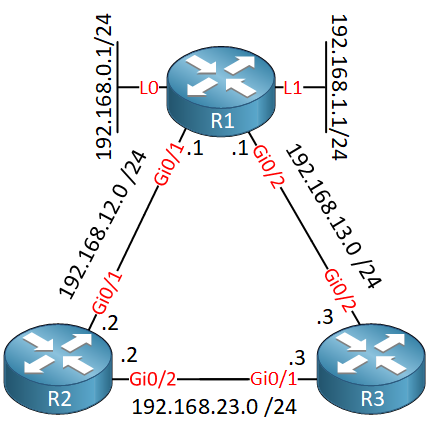When you configure an EIGRP summary route, all networks that fall within the range of your summary are suppressed and no longer advertised on the interface. Only the summary route is advertised.
What if you still want to advertise a network separately next to your summary route? This can be useful for traffic engineering. Luckily, this is possible with the summary leak-map. Let’s have a look…
Configuration
To demonstrate the summary leak-map, I will use three routers:

R1 has two loopback interfaces: 192.168.0.1/24 and 192.168.1.1/24. We are going to summarize these two networks.
Let’s start with a basic EIGRP configuration that advertises all interfaces:
R1#show run | begin router eigrp
router eigrp 1
network 192.168.0.0
network 192.168.1.0
network 192.168.12.0
network 192.168.13.0R2#show run | begin router eigrp
router eigrp 1
network 192.168.12.0
network 192.168.23.0R3#show run | begin router eigrp
router eigrp 1
network 192.168.13.0
network 192.168.23.0Let’s create a summary route for 192.168.0.0/24 and 192.168.1.0/24 and advertise it on both interfaces on R1:
R1(config)#interface GigabitEthernet 0/1
R1(config-if)#ip summary-address eigrp 1 192.168.0.0/23
R1(config)#interface GigabitEthernet 0/2
R1(config-if)#ip summary-address eigrp 1 192.168.0.0/23 Here are the routing tables of R2 and R3:
R2#show ip route eigrp
D 192.168.0.0/23
[90/130816] via 192.168.12.1, 00:01:10, GigabitEthernet0/1
D 192.168.13.0/24 [90/3072] via 192.168.23.3, 00:06:59, GigabitEthernet0/2
[90/3072] via 192.168.12.1, 00:06:59, GigabitEthernet0/1R3#show ip route eigrp
D 192.168.0.0/23
[90/130816] via 192.168.13.1, 00:01:00, GigabitEthernet0/2
D 192.168.12.0/24 [90/3072] via 192.168.23.2, 00:06:49, GigabitEthernet0/1
[90/3072] via 192.168.13.1, 00:06:49, GigabitEthernet0/2R2 and R3 don’t have any specific network entries for the loopback interfaces of R1, only a summary route.
What if I wanted R3 to use R2 to reach 192.168.0.1/24? Right now this is impossible because R3 is using its summary route.
What we can do, however, is use a leak-map on the summary that we advertise to R2 and advertise 192.168.0.0/24 separately. R2 will then advertise it to R3. With a more specific route, R3 will prefer R2 to get to 192.168.0.0/24.
Here’s how to do this:
R1(config)#ip access-list standard L0
R1(config-std-nacl)#permit 192.168.0.0 0.0.0.255
R1(config)#route-map L0_LEAK permit 10
R1(config-route-map)#match ip address L0First, we create an access-list that matches 192.168.0.0/24 and then a new route-map that refers to the access-list.
Now we change our summary command so that it includes the route-map:
R1(config)#interface GigabitEthernet 0/1
R1(config-if)#ip summary-address eigrp 1 192.168.0.0/23 leak-map L0_LEAKLet’s see how this affects the routing tables of R2 and R3:
R2#show ip route eigrp
D 192.168.0.0/23
[90/130816] via 192.168.12.1, 00:03:54, GigabitEthernet0/1
D 192.168.0.0/24
[90/130816] via 192.168.12.1, 00:00:24, GigabitEthernet0/1
D 192.168.13.0/24 [90/3072] via 192.168.23.3, 00:09:43, GigabitEthernet0/2
[90/3072] via 192.168.12.1, 00:09:43, GigabitEthernet0/1As you can see above, R2 now has a summary route and a specific entry for 192.168.0.0/24. Both use R1 as the next hop so it doesn’t affect R2. Let’s take a look at R3:
R3#show ip route eigrp
D 192.168.0.0/23
[90/130816] via 192.168.13.1, 00:04:00, GigabitEthernet0/2
D 192.168.0.0/24
[90/131072] via 192.168.23.2, 00:00:30, GigabitEthernet0/1
D 192.168.12.0/24 [90/3072] via 192.168.23.2, 00:09:49, GigabitEthernet0/1
[90/3072] via 192.168.13.1, 00:09:49, GigabitEthernet0/2R3 still has the summary route it learned on its GigabitEthernet 0/2 interface but also learns the 192.168.0.0/24 network from R2. Since this is a more specific route, R3 will use R2 to get to 192.168.0.0/24:
R3#show ip route 192.168.0.1
Routing entry for 192.168.0.0/24
Known via "eigrp 1", distance 90, metric 131072, type internal
Redistributing via eigrp 1
Last update from 192.168.23.2 on GigabitEthernet0/1, 00:01:42 ago
Routing Descriptor Blocks:
* 192.168.23.2, from 192.168.23.2, 00:01:42 ago, via GigabitEthernet0/1
Route metric is 131072, traffic share count is 1
Total delay is 5020 microseconds, minimum bandwidth is 1000000 Kbit
Reliability 255/255, minimum MTU 1500 bytes
Loading 1/255, Hops 2And here’s the summary route that R3 uses to get to 192.168.1.0/24:
R3#show ip route 192.168.1.1
Routing entry for 192.168.0.0/23, supernet
Known via "eigrp 1", distance 90, metric 130816, type internal
Redistributing via eigrp 1
Last update from 192.168.13.1 on GigabitEthernet0/2, 00:05:07 ago
Routing Descriptor Blocks:
* 192.168.13.1, from 192.168.13.1, 00:05:07 ago, via GigabitEthernet0/2
Route metric is 130816, traffic share count is 1
Total delay is 5010 microseconds, minimum bandwidth is 1000000 Kbit
Reliability 255/255, minimum MTU 1500 bytes
Loading 1/255, Hops 1That’s all there is to it.
Configurations
Want to take a look for yourself? Here you will find the final configuration of each device.


Hi Guys,
Great post, just have a question.
https://cdn-forum.networklessons.com/uploads/default/original/2X/4/4c676541a46c95aab858cc8a1e35b6a6702074be.png
In this an example of where 192.168.0.0 /24 is the longest prefix match over 192.168.0.0 /23 ?
What about in terms of lowest metric wins? Even though 192.168.0.0 /24 is the most specific route, the metric is higher than the summary route.
Hello Joseph
The metric will play a role only when comparing the exact same entries in the routing table. 192.168.0.0/23 and 192.168.0.0/24 are two different routing entries and thus each one has its own metric.
If they were the same and had a different metric, only one of them would end up in the routing table, so you would have no problem choosing which one to use. (Unless of course you use unequal cost load balancing for EIGRP, but that’s a different story.)
The first step when going through the routing table is to get the closest match of the destination
... Continue reading in our forumExcellent, I’ve got it now, thanks Laz!